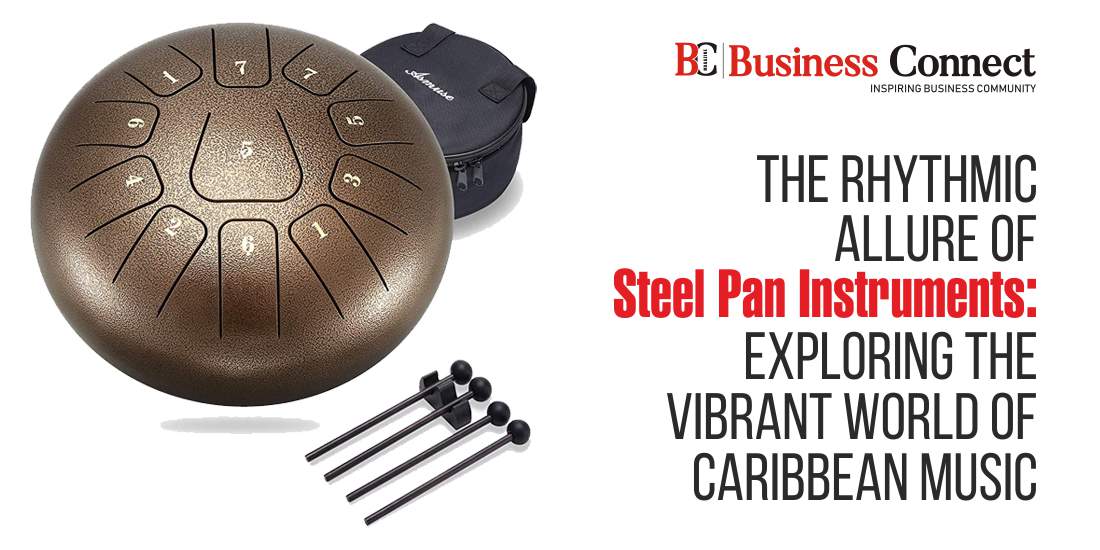The Rhythmic Allure of Steel Pan Instruments: Exploring the Vibrant World of Caribbean Music
Immerse yourself in the captivating world of steel pan instruments, also known as steel drums or pans. Originating in the vibrant Caribbean region, these unique percussion instruments have become iconic symbols of the rich musical heritage found throughout Trinidad and Tobago.
In this blog article, we will dive into the history, construction, playing techniques, and cultural significance of steel pan instruments. Join us on this rhythmic journey as we explore the mesmerizing sounds and infectious rhythms that emanate from these remarkable instruments.
The Origins and Evolution of Steel Pan Instruments:
The captivating sounds of steel pan instruments have deep roots in the cultural heritage of Trinidad and Tobago. Born out of the vibrant and diverse communities of the Caribbean, steel pans have evolved from humble origins to become powerful symbols of musical expression. In this section, we will explore the fascinating origins and the remarkable evolution of steel pan instruments.
The Early Beginnings:
The story of steel pans traces back to the early 20th century in Trinidad and Tobago. It is believed that the first steel pans were created by percussionists using discarded oil barrels or “drums” from the oil industry. Seeking to express themselves through music, these resourceful individuals transformed these discarded materials into musical instruments.
From Tamboo Bamboo to Steel Pans:
Prior to the use of steel pans, the people of Trinidad and Tobago used “tamboo bamboo” instruments, which were made from bamboo tubes struck against the ground. However, due to noise complaints and bans on the use of bamboo during the colonial era, the people turned to other materials, eventually leading to the birth of steel pan instruments.
The Rise of the Steel Pan Movement:
In the 1930s and 1940s, the steel pan movement gained momentum in Trinidad and Tobago. What started as a grassroots movement in impoverished neighborhoods quickly grew into a cultural phenomenon. Steel pan bands, known as “steelbands,” formed, and musicians showcased their talents during local festivities and competitions.
Innovation and Advancements:
Over the years, steel pan musicians and enthusiasts experimented with different techniques and materials to improve the sound and range of the instruments. Through trial and error, they discovered that specific areas of the steel drums produced distinct pitches, leading to the development of multiple notes or “pans” on a single drum.
Pan Tuning: A Masterful Craft:
One of the most critical aspects of the evolution of steel pans is the art of tuning. Skilled craftsmen known as “pan tuners” meticulously shape and temper the steel drums to create the desired notes and tonal qualities. Through careful hammering and shaping, the pan tuners bring out the resonant and harmonious sounds of the steel pan instruments.
Recognition and Global Influence:
In the mid-20th century, steel pan music gained international recognition. Steel pan bands began touring globally, captivating audiences with their infectious rhythms and melodic prowess. The unique sound of steel pans made its way into various music genres, influencing jazz, Latin, and popular music worldwide.
Technological Advancements:
With advancements in technology, the manufacturing process of steel pans has become more precise and efficient. Modern steel pan instruments are now crafted using computer-aided design (CAD) technology, ensuring consistent quality and precision tuning.
Today, steel pan instruments continue to evolve and thrive. From traditional calypso and soca rhythms to contemporary jazz fusion, the versatility and beauty of steel pan music mesmerize audiences around the world. This remarkable journey from humble drums to intricate musical marvels showcases the resilience, creativity, and cultural pride of the Trinidadian and Tobagonian people.
As we celebrate the origins and evolution of steel pan instruments, let us embrace the vibrant spirit and captivating melodies that these instruments offer. The legacy of the steel pan movement lives on, inspiring future generations of musicians and keeping the rich cultural heritage of Trinidad and Tobago alive through the enchanting sounds of steel pan music.
The Construction and Tuning of Steel Pans:
The construction and tuning of steel pans require meticulous craftsmanship and a deep understanding of the instrument’s unique characteristics. From shaping the raw materials to fine-tuning the individual notes, the process involved in creating steel pans is a true art form. In this section, we will delve into the intricate details of the construction and tuning of steel pans.
Selecting the Raw Materials:
The journey begins with selecting the appropriate raw materials for crafting steel pans. Traditional steel pans are made from oil drums, specifically 55-gallon barrels. These barrels are carefully chosen based on their quality and consistency. Each drum is thoroughly cleaned and prepared for the shaping process.
Shaping the Drum:
To create a steel pan, the drum undergoes a series of precise and meticulous shaping techniques. Skilled craftsmen, known as pan makers or pan builders, use various tools to transform the flat surface of the drum into a convex shape with distinct playing areas, or “notes.” The shaping process involves carefully hammering and sinking specific areas of the drum to create the desired pitches.
Tempering and Heat Treatment:
Once the shaping is complete, the drum is subjected to a process known as tempering or heat treatment. This involves heating the steel pan to a specific temperature and then cooling it gradually. Tempering enhances the strength and durability of the instrument while also affecting its tonal qualities and overall sound.
Marking and Layout:
After tempering, the pan maker marks the playing areas on the surface of the steel pan. These marks indicate where each note will be placed. The layout of the notes follows a circular pattern, with the bass notes located in the center and the higher-pitched notes radiating outward.
Cutting and Grooving:
Using specialized cutting and grooving tools, the pan maker carefully cuts and grooves the surface of the steel pan to create individual playing areas for each note. These playing areas, also known as “pans,” are carefully shaped to produce the desired pitch and resonance. The depth and shape of each pan are crucial in achieving the correct tonal quality.
Tuning the Notes:
Tuning is a critical step in the construction of a steel pan. Skilled pan tuners meticulously adjust the individual notes to ensure they are in tune with each other and produce harmonious sounds when played together. Tuning is achieved by carefully hammering and shaping the pan’s playing surface, fine-tuning each note until the desired pitch and tonal quality are achieved.
Fine-tuning and Voicing:
Once the initial tuning is complete, the steel pan undergoes further refinement through a process called fine-tuning and voicing. This involves carefully adjusting the shape and thickness of the notes to improve their resonance, sustain, and overall tonal balance. Pan tuners use their expertise and keen ears to bring out the full potential of each note and create an instrument that delivers a harmonious and balanced sound.
Surface Finishing and Decoration:
After the tuning process, the steel pan undergoes surface finishing and decoration. This includes cleaning, smoothing any rough edges, and applying protective coatings to prevent corrosion. Some steel pans are also decorated with intricate designs, adding visual appeal to the instrument.
The construction and tuning of steel pans require a delicate balance of skill, experience, and artistry. The pan makers and tuners dedicate countless hours to create instruments that embody the essence of the Caribbean’s vibrant musical heritage. The result is a harmonious masterpiece capable of producing the infectious rhythms and melodic beauty that define steel pan music.
Playing Techniques and Musical Expression:
Steel pan instruments offer a wide range of playing techniques that allow musicians to express themselves with rhythmic precision and melodic beauty. From striking the notes to incorporating subtle nuances, mastering these techniques is key to unlocking the full musical potential of steel pans. In this section, we will explore some of the primary playing techniques and the expressive possibilities they offer.
01. Striking:
The most fundamental technique in playing steel pan instruments is striking the notes. Using mallets or “sticks,” the player strikes the surface of the pan’s notes with a controlled force to produce distinct sounds. Each note has a specific pitch, and striking it precisely allows for the creation of melodies and harmonies. Varying the strength and angle of the strike can alter the dynamics and tonal qualities of the sound produced.
02. Rolling:
Rolling is a technique that involves rapidly striking adjacent notes in quick succession to create a rolling or cascading effect. This technique adds a fluid and continuous motion to the music, enhancing its rhythmic complexity and adding a sense of movement and energy.
03. Glissando:
Glissando is the technique of sliding the mallet or finger along the surface of the notes, producing a smooth and seamless transition from one pitch to another. This technique is often used to add expressive slides and embellishments to melodies, providing a subtle touch of emotion and color.
04. Muffling and Damping:
Muffling and damping techniques involve using the hands or fingers to partially or completely stop the vibration of the notes after striking them. This technique allows for precise control of the note’s sustain and decay, creating staccato or muted effects. Muffling and damping add rhythmic variation and dynamics to the music, adding depth and texture to the overall sound.
05. Harmonics and Overtones:
Steel pan instruments produce harmonics and overtones naturally, allowing for the creation of complex and rich soundscapes. Skilled players can manipulate these harmonics and overtones by striking the notes at different points or using specific techniques. This technique adds depth and complexity to the music, creating a multi-dimensional and immersive sonic experience.
06. Chords and Chord Progressions:
Steel pan instruments can produce chords by striking multiple notes simultaneously. This technique allows for the creation of harmonies and chord progressions, expanding the melodic possibilities of the instrument. By exploring different chord voicings and progressions, musicians can create lush and harmonically rich compositions.
07. Improvisation and Personal Expression:
One of the most exciting aspects of playing steel pan instruments is the opportunity for improvisation and personal expression. Skilled players can explore their creativity by improvising melodies, adding ornaments and embellishments, and infusing their unique musical personality into their performances. This allows for individuality and spontaneity, making each performance a unique and personal experience.
Steel pan instruments offer a world of rhythmic and melodic possibilities, allowing musicians to express themselves in vibrant and captivating ways. By mastering these playing techniques and incorporating personal creativity and expression, players can create music that resonates with listeners, evoking emotions and transporting them to the vibrant landscapes of the Caribbean.
Cultural Significance and Community Bonding:
Steel pan instruments hold immense cultural significance, particularly within the communities of Trinidad and Tobago where they originated. Beyond their musical prowess, steel pans serve as powerful symbols of cultural identity, community bonding, and celebration. They have become a source of immense pride, representing the resilience and creativity of the Trinidadian and Tobagonian people.
Carnival, the vibrant and exuberant festival celebrated in Trinidad and Tobago and other parts of the Caribbean, plays a significant role in showcasing the cultural significance of steel pan music. Steel pan bands, known as steelbands, take center stage during Carnival, captivating audiences with their infectious rhythms and lively performances. The pulsating beats of steel pans form the heartbeat of Carnival, creating an atmosphere of joy, unity, and celebration.
Steelbands have played a pivotal role in community bonding and social cohesion. These bands, often formed within neighborhoods and communities, serve as a focal point for people to come together, share their love for music, and foster strong bonds. Steelbands provide an inclusive space where individuals of all ages can participate, learn, and contribute to the collective musical experience. This sense of community and camaraderie transcends boundaries and unites people from diverse backgrounds.
The passing down of steel pan music from generation to generation is a testament to its cultural importance. Elders and experienced musicians within the community play a crucial role in teaching younger members, ensuring the preservation and continuity of the art form. This passing down of skills, techniques, and cultural knowledge not only safeguards the tradition but also strengthens intergenerational bonds and fosters a sense of belonging and cultural pride.
Steel pan competitions and festivals provide platforms for steelbands to showcase their skills and talents. These events bring together musicians, enthusiasts, and audiences from near and far, creating an atmosphere of excitement and friendly rivalry. They serve as opportunities to celebrate the cultural significance of steel pan music while fostering healthy competition and encouraging artistic excellence.
Beyond Trinidad and Tobago, steel pan music has gained recognition and appreciation worldwide. It has become a symbol of Caribbean culture, representing the vibrancy, resilience, and spirit of the region. Steel pan musicians and bands have traveled the globe, sharing their music and engaging in cultural exchanges, fostering understanding, appreciation, and cross-cultural connections.
Global Influence and Contemporary Innovations:
Steel pan instruments, originating from Trinidad and Tobago, have gained worldwide recognition and influenced musicians across the globe. The infectious rhythms and melodic beauty of steel pans have made a lasting impact on the global music scene, inspiring artists and captivating audiences worldwide.
One of the remarkable aspects of steel pans is their ability to facilitate cross-cultural collaborations. Musicians from diverse backgrounds come together to create unique musical fusions, incorporating steel pans into a wide range of genres such as jazz, Latin, reggae, and classical music. These collaborations not only showcase the versatility of steel pans but also foster cultural exchange and mutual appreciation among artists.
The influence of steel pans extends to popular music as well. Their vibrant and energetic sound has found its way into popular songs, adding a touch of Caribbean flavor and infusing the music with joy and uplifting vibes. Steel pans have become a recognizable and beloved element in the contemporary music industry.
Moreover, steel pan musicians and enthusiasts continually explore new genres and styles, pushing the boundaries of the instrument. They experiment with avant-garde compositions, venture into electronic music, and blend steel pans with various musical genres to create innovative sounds. These explorations expand the sonic possibilities of steel pans and contribute to the instrument’s evolving legacy.
Through their global influence and contemporary innovations, steel pan instruments transcend cultural boundaries and bring people together through the universal language of music. Their unique sound has captured the hearts of musicians and audiences alike, inspiring creativity and exploration in the world of music. As steel pans continue to make their mark on the global stage, their vibrant and captivating presence remains a testament to the enduring power of these remarkable instruments.
Conclusion:
The rhythmic allure of steel pan instruments is undeniable. From their humble beginnings to global recognition, these remarkable percussion instruments have played a pivotal role in Caribbean music and continue to inspire and captivate audiences worldwide.
Whether you’re drawn to the infectious rhythms, the melodic beauty, or the cultural significance, steel pan instruments offer a vibrant and uplifting musical experience. So, close your eyes, let the captivating sounds of the steel pan transport you to the sun-drenched beaches of the Caribbean, and immerse yourself in the joyous world of steel pan music.





